| Australian rules football in New South Wales | |
|---|---|
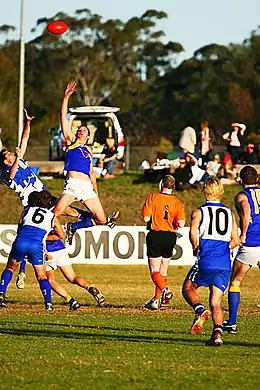 Two ruckmen contest the bounce in a suburban western Sydney AFL game between the East Coast Eagles AFC and Campbelltown Kangaroos AFC. | |
| Governing body | AFL NSW/ACT |
| Representative team | NSW/ACT |
| First played | 17 June 1865, Sydney[1] |
| Registered players | 71,481 (2023)[2] |
Club competitions | |
Audience records | |
| Single match | 72,393 (2003). Sydney Swans Football Club v. Collingwood Football Club. (Telstra Stadium, Sydney) |
Australian rules football in New South Wales is a team sport played and observed in the Australian state. It dates back to the colonial era in 1866, with organised competitions being continuous since the 1880s. Today, it is popular in several regions of the state, including areas near the Victorian and South Australian borders—Riverina, Broken Hill, and South Coast. These areas form part of an Australian cultural divide described as the Barassi Line. To the east of the line, it is known as "AFL", named after the elite Australian Football League competition. AFL NSW/ACT is the main development body, and includes the Australian Capital Territory.
Two teams currently compete in the professional Australian Football League (AFL): the Sydney Swans and the Greater Western Sydney Giants. The Swans in 1982 became the first professional Australian sporting team to move interstate. The Giants debuted in the 2012 AFL season and compete against the Swans in the Sydney Derby (also known as "The Battle of the Bridge").
The representative team, nicknamed the Blues, played Interstate matches against other Australian states and Territories between 1881 and 1988. Its long standing rivalry with Queensland saw them evenly matched since their first meeting in 1880. The Blues defeated Victoria in 1923 and in 1990 under State of Origin rules at the Sydney Cricket Ground. WR 'Billy' McKoy holds the record for the number of representative caps for New South Wales with 31.[3] Sydney hosted the national carnivals of 1914, 1933, 1960 and 1974. The underage Blues also claimed national AFL Under-19 Championships in 1974 and 1975 as well as a Division 2 title in 1993. The 1993 merger by the AFL into a composite NSW/ACT team ended over a century of representative competition.
Two leading pioneers of the sport, cousins Tom Wills and H. C. A. Harrison, were born in New South Wales. Hundreds of New South Welshmen have competed in the AFL, with notable players being Haydn Bunton Sr. and Jock McHale, now Legends in the Australian Football Hall of Fame. Current player Tom Hawkins holds the AFL record for playing the most games and scoring the most goals for a born and raised player with 332 games and 741 goals. Sophie Casey holds the AFL Women's record for the most games, while Haneen Zreika and Rebecca Beeson hold the record for the most goals for a female player.
History
Sydney
First clubs and matches (1865–1867)
On 26 May 1865, calls were put out to form a Sydney Football Club. The club was incorporated on 17 June 1865 with Richard Driver as its first president and up to 60 members, of whom were mostly cricketers.[1] It played its first match shortly thereafter in Hyde Park, Sydney, and in August against Sydney University.[4] Two other clubs, the Australian Club and a Sydney University team, played football matches against the Sydney club in 1865,[5] though it is not known under what code de Moore (2021) notes that accounts point to strong similarities with the Victorian code but with a strong influence of rugby.[6] Early matches were scored low, cancelled mid game, and were subjected to frequent disputes over the rules. The Sydney University club is often noted as "The Birthplace of Australian Rugby" in 1863; however, historical records show its incorporation in 1865 and that it did not begin playing regularly under rugby rules until 1869.
At its first annual meeting, the Sydney Football Club announced that it had formally adopted the Victorian football rules and encouraged Victorian clubs to travel north for intercolonial matches.[7] On 26 May 1866, the rules were published in Bells Life in Sydney.[7] The Australian Club formally adopted the code shortly after.[6]
During the 1860s, Sydney had a smaller number of clubs, compared to Melbourne's 12, playing in organised competitions.[8] Sydney, like Brisbane, could not recruit enough football players for organised football matches. As a result, the late 1860s had few clubs playing, and without intercolonial competition, newcomer clubs soon disbanded.[9] Newcastle revised the Rules of Football (the Victorian Rules), and was published in the press in that city.[7]
One of the first Sydney schools to adopt the code was Newington College in 1867, before becoming the first Australian school to play rugby in 1869.[10] With the growing rivalry between the two colonies, Sydney journalists criticised the code in 1868, protesting that the "old English game of football" would be preferable to Sydneysiders than a game imported from the rival Colony of Victoria.[11] In 1869, Newington College replaced the codes, becoming the first Australian school to play rugby in 1869.[10]
Despite the formation of football clubs adopting English rules, rugby footballers could manage just four matches prior to the 1870s.
Revival and rugby takeover (1868–1876)
In 1868, a new Sydney Football Club was founded with Victorian rules to play over rugby, citing the code of Melbourne. Details of matches played under the Victorian rules were scant; however, a match was held against the 60th Queen's Own Regiment on 11 July 1868.[12] The new Sydney club would soon suffer the same fate, as its predecessor and organised football team disappeared completely.
In the 1870s, rugby was integrated into schools, later producing organised competitions between clubs. Soon after, rugby spread throughout the colony. The cause of the code's disappearance in New South Wales was that the newly formed New South Wales Rugby Union in 1874 banned member clubs from playing matches under Victorian rules.
Intercolonial competition and NSWFA era (1877–1893)
Some players, I am aware, can't swallow the idea of adopting the Victorian Game, simply because it is supposed to hail from the sister colony.
Reporter, The Sydney Mail[13]
In June 1877, Sydney's Waratah Rugby Football Club (now defunct) accepted a challenge from Victoria's Carlton Football Club to reciprocal matches in their respective codes. The first match, hosted by Waratah, was played at the Albert Ground under rugby rules in front of 3,000 spectators—then the largest ever football crowd in Sydney—was won by Waratah 2–0. Defunct newspaper publication The Argus noted that the Victorians were not lacking in skills, just their knowledge of the game.[14] The second match was played in front of a smaller crowd of about 1,500 at the Albert Ground with the result being Carlton 6–0. Among the best players were George Coulthard, who showed a particular prowess in both codes despite having never played rugby. When Waratah toured Victoria in July 1878, a crowd of 8,000 at the Melbourne Cricket Ground witnessed Carlton and Waratah draw scores in rugby, while a smaller crowd of 6,000 witnessed a surprise victory against Carlton by 2 goals in Victorian rules.[15]
By 1880, Waratah and other Sydney clubs began initiating changes to rugby rules.[16] Rugby interests, however, repeatedly rejected suggestions to switch codes or even play intercolonial matches under alternating rules against Victoria. In response, the proponents of the Australian game formed the New South Wales Football Association (NSWFA) in 1880. In 1881, the first Australian rules game between NSW and Victoria was played in Sydney.[17] The NSWFA only had a few clubs, including Waratah which switched codes in 1882. Until 1889, competition wasn't present when clubs competed for the Flanagan Cup. Despite this, the Sydney Rugby Football Union, seeing the new competition as a threat, enforced a strict ban on every one of its member clubs playing Victorian rules.[18]
South Melbourne was the second club to visit New South Wales in 1883, defeating Sydney by just a single goal in front of a large crowd at the Sydney Cricket Ground,[19] and in a goal in front of 600 spectators during a game against East Sydney Football Club.[20] Waratah played against South Australia in 1884 at Moore Park.[21]



New South Wales competed against Queensland in 1884, initially losing to its northern neighbour before gaining primacy in their 1886 matches. It also competed against a touring New Zealand Native football team on 29 June 1889, with the result being a 4–4 draw.[22]
The Northern District Football Association around Newcastle began in 1886, with teams from 1888 competing for the Black Diamond Cup, though participation by local clubs continued to be sporadic from 1881.[23]
The NSWFA had trouble gaining access to enclosed grounds and gate receipts. With its two clubs divided, it collapsed in 1893.[24]
Post-Federation, NSW Football League era: 1903–1917
With the Federation of Australia, the Australian code was revived. The NSW Football League, later the NSW Australian Football League (NSWAFL), was formed on 12 February 1903 at a meeting held in the YMCA Hall in George St. The NSWAFL promoted the game in schools and lobbied for VFL exhibition matches in Sydney to promote the code.

The first Victorian Football League match played in Sydney was with Fitzroy Football Club 7–10, defeating the Collingwood Football Club 6–9 at the Sydney Cricket Ground on 24 May 1903.[25] The large attendance of 20,000 saw the exhibition hailed as a success and inspired the league to continue scheduling more matches in Sydney. However, follow-up matches quickly began to attract cynicism from the Sydney football public, as a VFL push when Geelong Football Club 8.7 (55) defeated Carlton Football Club 6.9 (45) at the SCG a few months later. The matches were seen by the Sydney media as an attempt to force-feed the Victorian game to Sydneysiders who had plenty of rugby to attract their ongoing interest. The crowd of 5,000 was much smaller than those of rugby games in the city.[26] In 1904, Melbourne Football Club 9–17 (71) defeated Essendon Football Club 6–3 (39) in front of 6,000 people.[27] Without any interest, top-level VFL disappeared from Sydney for decades.
In contrast to the reception of the game at professional level, the grassroots level was having enormous success, growing the game in the schools with 48 in Sydney, including all the Roman Catholic schools playing Australian Football, by 1905.[28]
In 1907, New South Wales defeated South Australian powerhouse Port Adelaide Football Club 8–9 to 5–14 in front of 4,000 spectators at Sydney Showground.[29] Another South Australian club, Norwood Football Club, toured with Victorian club Carlton, playing a match in front of 7,000 at the Showgrounds.[30] North Adelaide Football Club also toured in 1910 to play against New South Wales at Erskineville Oval, which attracted 2,000 spectators.[31] In 1911, Geelong toured and played a combined Sydney side at Alexandria in front of 6,000 spectators.[32] Dally Messenger contributed to the paid football code of rugby league; as a result, rugby established itself into the culture of Sydney in 1908.
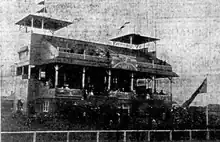
Although Australian football remained popular, the NSWAFL was still denied access to enclosed grounds, and the new professional code of rugby league further lured players from Australian rules. By 1911, however, Australian rules were supported more than the rugby union, according to The Referee.[33]

Interwar popularity surge, interstate success, and proposed Rugby League amalgamation: 1918–1939
Popularity peaked in 1921 when attendances at the Sydney competition grew from hundreds to thousands.[34] While increased gate takings were funding an increase in playing standard and junior development, the local league had exclusive access only to Erskineville Oval and Hampden Oval, relatively small grounds, and had difficulty scheduling matches used by the rugby authorities.[34]

During the 1920s, funded by a NSWAFL in Sydney and a thriving schoolboys competition, NSW defeated Victorian sides on several occasions at home, notably Melbourne Football Club on 28 July 1923,[35] the VFL at the SCG in 1923, and again at Erskineville Oval by one point on 15 August 1925.[36]

The Australian National Football carnival of 1933 was held at the Sydney Cricket Ground. Several matches drew large crowds, particularly those involving New South Wales, Victoria, Queensland, South Australia and West Australia.

Following the successful interstate football carnival in 1933, a proposal by the New South Wales Rugby League to amalgamate Australian football and rugby league was investigated. A report, with a set of proposed rules known as Universal football, was prepared by the secretary of the NSWRL, Harold R. Miller, and sent to the Australian National Football Council. A trial game was held in secret, but plans were never instituted.
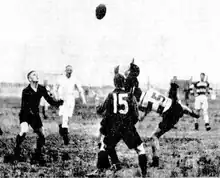
Three of the original NSWAFL clubs are still in existence and currently play in the Sydney AFL: North Shore, East Sydney (now UNSW-ES), and Balmain, but the league remained almost entirely amateur with limited audience following and sponsorship.
Post-war decline: 1945–1981
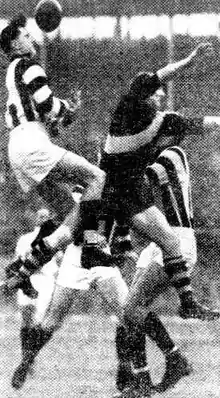
World War II proved a massive setback for the code in Sydney; the government insisted that the league cease operations. Struggling Sydney clubs were propped up by visiting servicemen from traditional Australian rules states. Despite this, between 1953 and 1957, the game survived in parts of Sydney, Newcastle, and Wollongong. Several junior clubs and leagues were established.[37] The St. George and Sutherland Shire Junior Australian Football Association was established in southern Sydney and consisted of Penshurst Junior Australian Football Club (JAFC) Panthers, Miranda JAFC Bombers, St. Patrick's Ramsgate (later Ramsgate JAFC Rams), Heathcote JAFC Hawks, Cronulla JAFC Sharks, Peakhurst, Como-Jannali, Boys' Town, Cronulla Blues, and St. Patrick's Sutherland.
Top level VFL returned to the SCG on 14 June 1952 when Collingwood 10–12 (72) defeated Richmond 5–6 (36) in front of 24,174 spectators. However, the league would not return for another few decades.
Sydney Swans era: 1981–present
In 1979, the VFL scheduled 2 premiership matches for the Sydney Cricket Ground. On 10 June 1979, Hawthorn 23–18 (156) defeated North Melbourne 16–9 (105) in front of a large crowd of 31,395. However, a few months later, 17,140 attended a match in which Richmond 22–20 (152) defeated Fitzroy 20–15 (135). Fitzroy Lions, in a financial struggle, was prevented from conducting a feasibility study into the possibility of moving to North Sydney; a proposal was put forward, but was voted down by its board in 1980.[38] The VFL scheduled 4 matches for the SCG in 1980, with its purpose to test the market. The VFL's market studies found an increase in television ratings in Sydney and sustained attendance at matches. Based on the market study, the VFL stated that there was sufficient support for a Sydney team, and that it intended to have one, possibly as soon as 1982.[39] A 1981 report by Graham Huggins concluded that there was an "untapped market" in Sydney.[40] In 1981, the VFL had decided that it would establish an entirely new 13th VFL club in Sydney.[40] With the results, South Melbourne announced its move to Sydney.
The first professional VFL or AFL players were from Sydney, and the Sydney AFL did not begin to emerge until the 1980s. Russell Morris was one of the earliest players, followed by Sanford Wheeler, Mark Roberts, Greg Stafford, Nick Davis and Lenny Hayes. In recent years, there has been a dramatic increase in AFL players coming from the Sydney region, and in 2007, a total of 11 AFL players identified themselves as coming from this region.[41]
Riverina
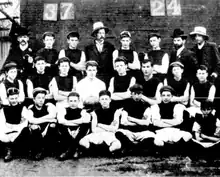
Australian Football was introduced to the Riverina region of New South Wales in Wagga Wagga in 1881, with a match between sides from the Wagga Wagga Football Club and Albury Football Club.[42] Subsequently, a local competition formed in 1884 around Wagga Wagga. The league went through many incarnations including the:
- Wagga Football Association (1888[43]–1889).
- Wagga United Football Association (1890[44]–1897).
- Murrumbidgee District Football Association (1897).
- Wagga United Football Association (1898–1921).
- Riverina Mainline Football Association (1922).
- Wagga United Football Association (1923,[45] 1924,[46] 1925[47]).
- The Rock and District Association (1926–1927),[48] district towns based teams competition.[49]
- Wagga and District Association (1926–1927), Wagga based teams competition.[50][51]
- Wagga Football Association (1928–1957).
The South West Football League (New South Wales) was founded in 1894.
In 1905, the Wagga Football Association representative side lost a close match against the Fitzroy Football Club at Wagga.[52]
In these early days, the Ovens and Murray Football League produced champion players including Haydn Bunton, Sr., who was born in Albury and played with the Albury Rovers FC, Albury Football Club, and West Albury prior to playing with Fitzroy in the VFL in 1931.
In 1944, rugby authorities from Sydney began a campaign to oust Australian rules from the Riverina, successfully campaigning for it to be banned from public schools in Albury, Wagga, and Junee to be replaced by Rugby League in an effort to expand the code into Victoria.[53]
The Farrer Football League superseded the Albury & District Football League in 1957.
During the 1970s, the region had famous footballer family the Danihers: Terry Daniher, Neale Daniher, Anthony Daniher, and Chris Daniher.
In 1982, at the instigation of the Victorian Country Football League (who had jurisdiction over the area at the time), the South Western District Football League, the Farrer Football League, and the Central Riverina Football League were all combined into the Riverina Football League and the Riverina District Football League. The district league reverted to the Farrer Football League in 1985. There were two divisions of the Riverina DFL / Farrer FL between 1983 and 1994. In 1995, these two leagues were part of the Murrumbidgee Valley Australian Football Association.
Further south towards the Murray River, the Ovens & Murray Football League included teams from Albury that formed as the Ovens & Murray Football Association in 1893.
Clubs also formed in the smaller towns around the mid to late 1890s and early 1900s and played ad hoc fixtures against each other, as well as organising formal competitions during the first half of the 1900s in Southern Riverina and Central Riverina, such as the:
- Federal District Football Association 1897–1902
- Deniliquin Football Association: 1900–1932
- McLaurin Football Competition: 1901
- Southern Riverina Football Association: 1905–1931
- Greengunyah Football Association: 1906
- Corowa & District Football Association: 1906–1907
- Central Riverina Football League: 1907[54]
- Lockhart Football Association: 1908–1909, 1911–1914, 1921, 1925
- Coreen & District Football Association: 1909–1930
- The Rock Football Association: 1910–1911, 1914
- Culcairn & District Football Association 1910–1913, 1919–1921
- Barellan & District Football Association: 1912[55]
- Walbundrie Football Association: 1914
- Milbrulong Football Association: 1914–1915
- Walla Walla Football Association: 1915–1916, 1919–1921
- Urangeline Football Association: 1919–1926
- Faithful & District Football Association: 1920–1939
- Borree Creek Football Association: 1922
- Hume Football Association: 1922–1926
- Lockhart Oaklands Line Football Association: 1923–1924
- Riverina Football Association: 1924–1929
- Osborne & District Football Association: 1927–1928
- Lockhart & District Lines Football Association: 1929
- Central Hume Football Association: 1929–1934
- Albury & District Football League: 1930–1957
- Corowa & District Football Association: 1931–1935
- Coreen & District Football League: 1936–2007
At the conclusion of the 2007 season, the Coreen league was disbanded with most of its clubs joining the Hume league for the 2008 season.
In the modern era, the Riverina had many players for the VFL/AFL, including champions such as Wayne Carey, Paul Kelly, Dennis Carroll, John Longmire, Leo Barry, Shane Crawford, and Brett Kirk. Some other players from the region to have played AFL level football include Isaac Smith, Luke Breust, Zac Williams, Dean Terlich, and Sam Rowe.
Australian rules football is the most popular sport in Albury, but is behind rugby league as the largest sport in Wagga Wagga and Griffith.
Western New South Wales
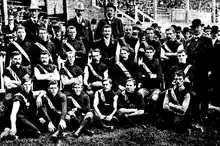
Australian football was first played in Broken Hill in 1885 between Day Dream and Silverton. Informal competition began in 1888 between four clubs. The Barrier Ranges Football Association formed in 1890, which later became the Broken Hill Football League. In recent years, the area has players such as Dean Solomon, Brent Staker, and Taylor Walker. Steve Hywood played on the half-back flank for Richmond in the 1972 VFL Grand Final, losing to Carlton. Due to transfer problems, he resumed his career at Glenelg in 1973 and played in the 1973 Glenelg Premiership team. Hywood was seen as one of the best back flankers ever to play the game.[56]
Newcastle

Australian football was introduced to Newcastle, New South Wales, in 1883 when the Wallsend and Plattsburg Football Club was formed by miners from Ballarat.[57]
In 1888, the Black Diamond Cup, Australia's oldest existing and active sporting trophy, was first awarded to the champion team in the region.[57][58][59] In 1889, a donation of five guineas each from Northern Districts Football Association (Australian Rules) patron[60] Mr. Stewart Keightley and the proprietors of the Newcastle Morning Herald led to the procurement of the Junior Challenge Cup.[61] This Cup was supplied by A. J. Potter (Alfred John Potter), watchmaker, and jeweller of Hunter Street Newcastle.[62]
Five clubs were established in the Newcastle area: Newcastle City, Wallsend and Plattsburg, Northumberland, Lambton, and Singleton.
In 1883, a touring South Melbourne Football Club defeated a combined Northern District team by only one goal. In 1888, a touring defeated Wallsend by 10–5. The following year, Wallsend defeated Fitzroy. Isaac Heeney was drafted by the Sydney Swans in 2014, making him the first Newcastle-born footballer to play in the AFL.
South Coast
The game was first played at a senior level in 1969.[63] There are eight teams that compete in the AFLSC senior's competition and 11 teams in the reserves. In terms of junior numbers, there has been a significant expansion since 1999.[64] AFL players originating from the South Coast include Arthur Chilcott, Aidan Riley, and Ed Barlow.[65]
North Coast
The game was first played in the Coffs Harbour area as late as 1978. The North Coast Australian Football League was formed in 1982 and grew rapidly with up to eight clubs by 2000. In recent years, the number of clubs has declined due to Woolgoolga, Nambucca, Kempsey, and Urunga folding. North and South Coffs were forced to merge before the start of the 2015 season due to lack of player numbers. The area includes AFL player Sam Gilbert.
VFL / AFL competition in NSW
Establishment of a Sydney VFL team and relocation of the Swans
In 1977, Ron Barassi proposed the VFL setting up a club in Sydney, which he offered to coach believing that it would help spread the code in the state.[66] The following year, the league investigated playing Sunday matches at the SCG.[67] The VFL scheduled 2 premiership matches for the SCG in 1979. One of them, between the previous year's grand finalists North Melbourne and Hawthorn, drew a record 31,395 to the gates. Researching and testing the market, the VFL scheduled four matches for the SCG in 1980 with an average attendance of 19,000. In April 1980, the VFL stated that its market study showed there was sufficient support for a Sydney team, finding that there was an increase in television ratings in Sydney and sustained attendance at matches and that it intended to have a team in Sydney, possibly as soon as 1982.[68] A 1981 report by Graham Huggins concluded that there was an "untapped market in Sydney which represented an excellent opportunity for the league."[40] The report claimed that 60,000 people in Sydney had stated that they would regularly support the new club: 90% of these supporters would watch VFL on television from Sydney, 80% of these supporters had not attended rugby, and 92% believed that Australian rules could become popular in Sydney.[69] Following the report, the VFL announced that the league had decided to put a team in Sydney in 1982.[40] Financially struggling VFL club South Melbourne, fearing a missed opportunity to establish a new market, announced its decision to play all 1982 home games in Sydney. After playing, the VFL formally approved the Swans shift to Sydney on 29 July 1981,[70] becoming the first team based outside of Victoria. In 1982, the club was renamed the Sydney Swans. The relocation of Swans from South Melbourne to Sydney included sponsorship away from the local Australian rules football clubs and leagues, and there was an initial decline in the sport locally. The Swans' debt, much of it to the AFL, not only hung over attempts to establish the Sydney Swans but now burdened Australian rules football in New South Wales.
On 31 July 1985, Dr. Geoffrey Edelsten, through Powerplay Limited, bought the Sydney Swans for $2.9 million in cash with debt payments, funding and other payments spread over five years. Powerplay was floated and sold shares to supports and the public, but with only a licence for the team and debts, the uptake was poor. Within less than twelve months, Edelsten resigned as chairman, and by 1988, the licence was sold back to the VFL for just $10. The AFL appointed a board to operate the team in order to take control of the club's financial losses. Board members Mike Willesee and Craig Kimberley, together with Basil Sellers Peter Weinert as a consortium known as the Private Ownership Group, purchased the licence and operated the Sydney Swans until 1993, when the AFL again took over ownership of the team.
With substantial monetary and management support from the AFL, the Sydney Swans continued and with player draft concessions in the early 1990s, has fielded a competitive team throughout the decade. In 1996, the Swans lost the grand final to North Melbourne, which had been their first appearance in a grand final since 1945. The game was played in front of 93,102 at the MCG. Since 1995, the Swans have only missed the finals five times, including in the COVID-affected 2020 season, in which they played only four home games and finished third to last on the ladder.
The culmination of the recent success was the 2005 premiership against the West Coast Eagles, played in front of 91,898 at the MCG, taking the flag to Sydney for the first time and breaking a 72-year drought for the club from when it was based in South Melbourne. It also broke the longest premiership drought in the history of the competition.[71] Another flag followed not long after, in 2012.[72]
The AFL had eventually established the Swans in Sydney but the model of off-loading a debt-laden team to a new market had resulted in enormous cost to the AFL passed on to its other member clubs, and ultimately supporters. Despite the eventual success of the Swans, the former Melbourne based club had struggled for many years to gain support of the Sydney public, and the AFL and Australian rules football are still far behind rugby league in the Sydney market.
Establishment of a second AFL Team: Greater Western Sydney Giants
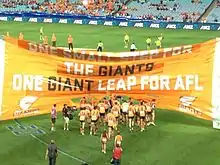
The Australian Football League expressed intentions to invest in junior development in the growing Sydney market, particularly in Sydney's west and compete head on with the established rugby football codes.
A second team in Sydney was founded in 1999, when Sydney became a target for the proposed relocation of the North Melbourne Football Club. However, poor attendance at the club's home matches, low television viewership, and strong opposition from the Sydney Swans saw an end to the initiative.[73]
In 2005, the AFL went on a Sydney-centric recruitment drive, offering a NSW scholarships program and young apprentice scheme.[74] By 2007, at least two of the NSW and ACT scholarship recipients had been officially promoted to AFL rookie lists, qualifying them for selection in the senior squad in the event of long-term injury to listed players.
In 2008, the AFL stated their intention to establish a second team in Sydney to be based in the western suburbs, as part of the expansion of the competition. This process was completed with the establishment of the Greater Western Sydney Giants, who played for a season in the North East Australian Football League prior to commencing competition in the Australian Football League in 2012. The Giants struggled in their early years, winning only three games in their first two seasons, but since then, made gradual progress up the ladder, culminating in a Grand Final appearance in 2019.[75] Although the Giants have been somewhat successful on the field, despite more than $200 million in AFL investment, the club has made little impact in growing attendance, television viewership, or participation in the region.[76][77]
AFL NSW/ACT Commission Limited
The AFL established the AFL NSW/ACT Commission Limited to govern its expansion in New South Wales and the Australian Capital Territory.
AFL Women’s
GWS was awarded a license for the inaugural AFL Women's season with the Sydney Swans, deciding not to bid for entry until later.[78]
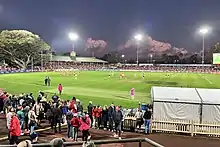
Sydney was awarded a license in 2021 and made its debut in round 1 AFL Women's Season 7 match against St Kilda at the North Sydney Oval. It set a new record for a crowd in a stand-alone women's Australian rules football in New South Wales on 27 August 2022, with 8,264 in attendance.[79]
Participation
Ausplay reported that there were 69,168 regular participants in Australian rules in New South Wales in 2019.[80]
While lower than the AFL reported figure for 2011 of 131,829 (which included the ACT and 41,626 Auskick registrations), the state has now eclipsed rugby union participation in New South Wales.[81]
In 2012, the figure was 148,230 people of which 48,965 were Auskick registrations.[82] In 2013, the number of Australian football participants in NSW, and the ACT had jumped up to 177,949, of which 47,888 were Auskick participants.
The Australian Bureau of Statistics "Children's Participation in Cultural and Leisure Activities, Australia, Apr 2009" estimated 18,000 Australian rules football participants in NSW and 1,400 in the ACT.[83] The ABS used a small sample size of 20,126 private dwelling in obtaining their data of participation numbers for the 2011/12 season.[84]
In 2007, there were 7,225 senior players in NSW and the ACT and in 2006, a total of around 95,100 participants.[85] Although Australian rules football was one of the fastest growing sports in the state, the overall participation per capita was only about one percent, the lowest in Australia.
Registered players (Excluding Auskick registrations)
| 2016 | 2019 | 2023 |
|---|---|---|
| 51,177 | 69,168 | 71,481 |
Audiences
Attendance Record
- 72,393 (2003). AFL Sydney Swans v. Collingwood Football Club at Stadium Australia, Sydney.
Attendances
In 2006, the Sydney Swans averaged 41,205 people through the gate per home match. In 2013, the average had decreased to 29,104, with the suggestion that this was partly due to the redevelopment of the Bradman Stand at the SCG.[86]
Major Australian rules football events in New South Wales
- Sydney Derby, also called The Battle of the Bridge – Swans v Giants (held twice annually at ANZ Stadium starting in 2012)
Players
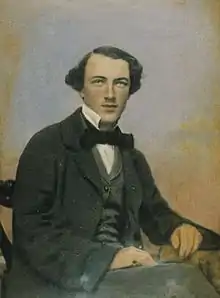
Past Greats and Hall of Fame members
A number of notable players have been born in New South Wales or played the majority of their junior careers in New South Wales; many of these players have been from the traditional Australian rules football areas of Broken Hill or the Riverina. Australian football pioneers Tom Wills and H. C. A. Harrison were born in New South Wales in the 1830s.
Notable players from the Riverina include: Australian Football Hall of Fame Legend Haydn Bunton, Sr. (Albury), who was the first player born in New South Wales to win the Brownlow Medal and the Sandover Medal, in 1931 and 1938 respectively; Bill Mohr of Wagga who kicked 735 league goals; Paul Kelly from Wagga the first New South Welshman to win the Brownlow, Shane Crawford (Finley) who won the Brownlow in 1999; and Wayne Carey (Wagga), won the Leigh Matthews Trophy twice in the 1990s. Notable players from Broken Hill include Dave Low, Robert Barnes and Bruce McGregor, who all won Magarey Medals in the 1910s and 1920s, and Jack Owens, a three-time South Australian National Football League (SANFL) leading goalkicker.
Many notable players have also been recruited from Sydney, with football having been played in the city since 1880, pre-dating other major sports.[87] Despite the lack of media attention the game has received, Sydney has still generated many players of high quality. Notable people include Bob Merrick (a leading goal kicker in the 1920s recruited from East Sydney), Roger Duffy (1954 premiership player who was recruited from Newtown), Mark Maclure (multi-premiership player and Carlton FC captain), Michael Byrne (1983 premiership player with Hawthorn who was recruited from the Sydney club of North Shore), Mark Roberts (202-game AFL player from 1985 to 1999 who played junior football for Ramsgate AFC and senior football for St. George AFC before playing in the AFL for the Sydney Swans), Brisbane Bears, and North Melbourne, notably in their 1996 premiership, Greg Stafford (a 200-game player recruited from Western Suburbs in Sydney), Jarrad McVeigh (2012 AFL premiership captain) and his brother Mark (who played for Essendon), Lewis Roberts-Thomson (2005 and 2012 premiership player for the Swans) and Lenny Hayes (2010 Norm Smith Medallist), amongst others.[88]
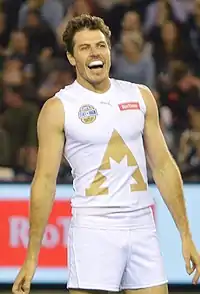 Isaac Smith, Hawthorn and Geelong premiership player is from Cootamundra
Isaac Smith, Hawthorn and Geelong premiership player is from Cootamundra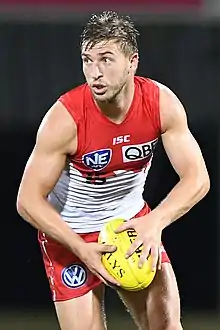 Keiren Jack, former Sydney Swans captain is from Sydney. His father Garry Jack was an Australian representative rugby league footballer.
Keiren Jack, former Sydney Swans captain is from Sydney. His father Garry Jack was an Australian representative rugby league footballer. Matt Suckling, premiership player, is from Wagga
Matt Suckling, premiership player, is from Wagga_(cropped).jpg.webp) Jarrad McVeigh Sydney Swans premiership player is from Sydney
Jarrad McVeigh Sydney Swans premiership player is from Sydney.jpg.webp) Cameron Mooney 3 time premiership player is from Wagga
Cameron Mooney 3 time premiership player is from Wagga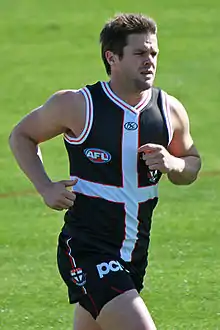 Adam Schneider Sydney premiership player is from Osborne
Adam Schneider Sydney premiership player is from Osborne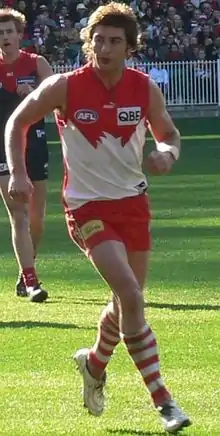 Brett Kirk, Sydney Swans premiership player and coach is from Albury
Brett Kirk, Sydney Swans premiership player and coach is from Albury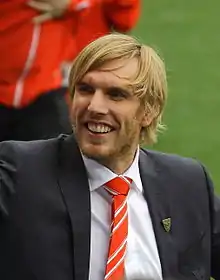 Lewis Roberts-Thompson Sydney Swans premiership player is from Sydney
Lewis Roberts-Thompson Sydney Swans premiership player is from Sydney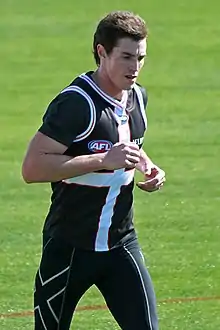 Lenny Hayes AFL Hall of Famer is from Sydney
Lenny Hayes AFL Hall of Famer is from Sydney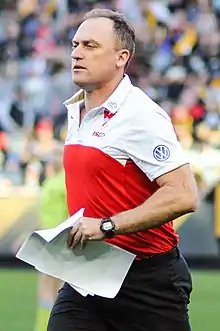 John Longmire premiership player and coach is from Corowa
John Longmire premiership player and coach is from Corowa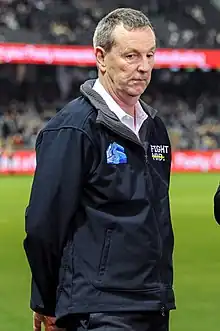 Neale Daniher is from West Wyalong
Neale Daniher is from West Wyalong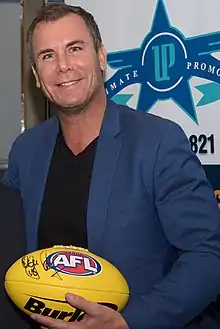 Wayne Carey North Melbourne premiership captain is from Wagga
Wayne Carey North Melbourne premiership captain is from Wagga_(7176553482).jpg.webp) Statue of Paul Kelly, Brownlow Medallist Sydney Swans captain and rugby league convert was from Wagga
Statue of Paul Kelly, Brownlow Medallist Sydney Swans captain and rugby league convert was from Wagga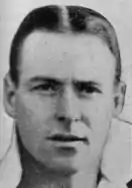 Bill Mohr of Wagga kicked 735 league goals
Bill Mohr of Wagga kicked 735 league goals Bruce McGregor was from Broken Hill
Bruce McGregor was from Broken Hill Haydn Bunton Sr. was from Albury
Haydn Bunton Sr. was from Albury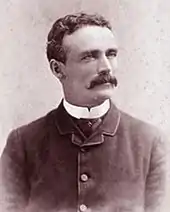 H. C. A. Harrison one of the fathers of Australian Rules Football was from Picton
H. C. A. Harrison one of the fathers of Australian Rules Football was from Picton
Men's
Current players
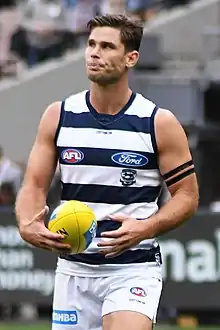 Tom Hawkins, Geelong premiership player is from Finley
Tom Hawkins, Geelong premiership player is from Finley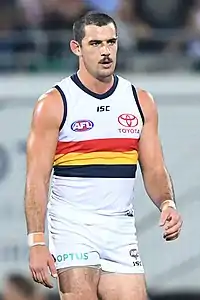 Taylor Walker, former Adelaide captain is from Broken Hill
Taylor Walker, former Adelaide captain is from Broken Hill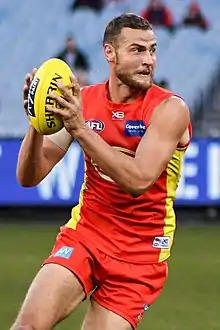 Jarrod Witts is from Normanhurst in Sydney
Jarrod Witts is from Normanhurst in Sydney Harry Cunningham is from Wagga Wagga
Harry Cunningham is from Wagga Wagga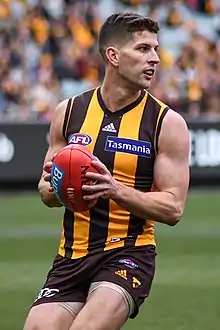 Luke Breust, Hawthorn premiership player is from Temora
Luke Breust, Hawthorn premiership player is from Temora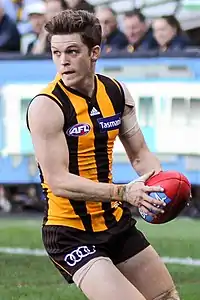 Taylor Duryea, Hawthorn premiership player is from Corowa
Taylor Duryea, Hawthorn premiership player is from Corowa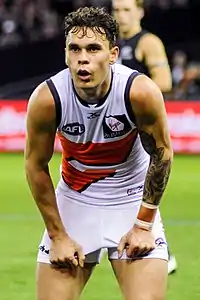 Zac Williams is from Narrandera
Zac Williams is from Narrandera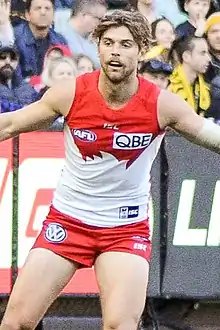 Dane Rampe is from Clovelly in Sydney
Dane Rampe is from Clovelly in Sydney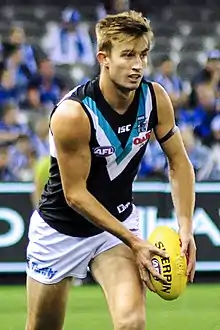 Dougal Howard is from Wagga Wagga
Dougal Howard is from Wagga Wagga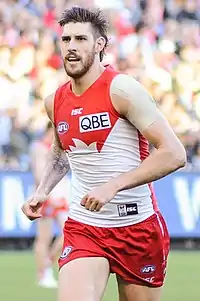 Sam Naismith is from Gunnedah
Sam Naismith is from Gunnedah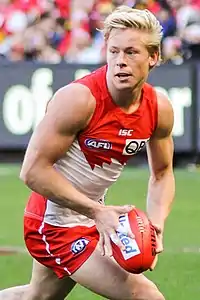 Isaac Heeney is from Maitland
Isaac Heeney is from Maitland Jeremy Finlayson is from Culcairn
Jeremy Finlayson is from Culcairn Jacob Hopper is from Leeton
Jacob Hopper is from Leeton Daniel Lloyd is from the Central Coast
Daniel Lloyd is from the Central Coast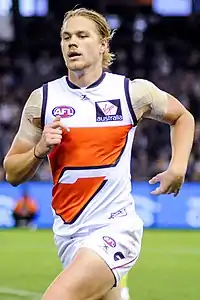 Harrison Himmelberg is from Wagga Wagga
Harrison Himmelberg is from Wagga Wagga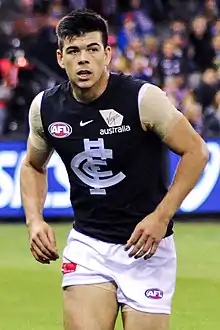 Matthew Kennedy is from Collingullie
Matthew Kennedy is from Collingullie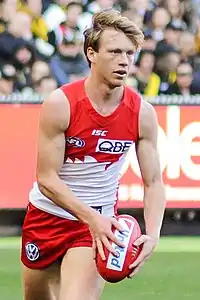 Callum Mills is from Northern Beaches in Sydney
Callum Mills is from Northern Beaches in Sydney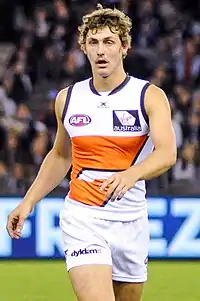 Harry Perryman is from Collingullie
Harry Perryman is from Collingullie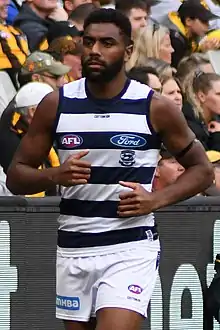 Esava Ratugolea is from Griffith
Esava Ratugolea is from Griffith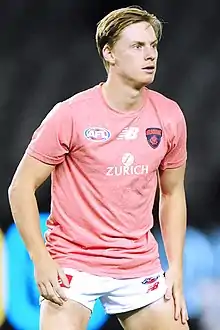 Charlie Spargo is from Albury
Charlie Spargo is from Albury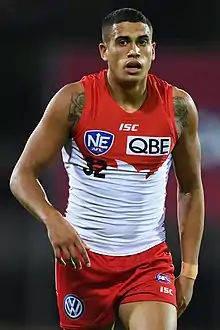 James Bell is from Shellharbour
James Bell is from Shellharbour
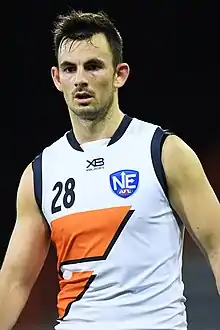 Zach Sproule is from Albury
Zach Sproule is from Albury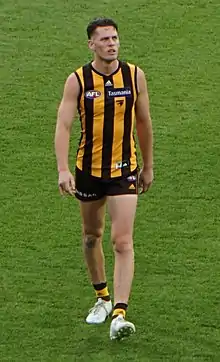 Jacob Koschitzke is from Albury
Jacob Koschitzke is from Albury_16.04.21.jpg.webp) Samson Ryan is from Pambula
Samson Ryan is from Pambula.jpg.webp) Jacob Bauer is from Wollondilly Shire in Greater Western Sydney
Jacob Bauer is from Wollondilly Shire in Greater Western Sydney
AFL players from NSW
| Currently on an AFL senior list |
| Player | NSW junior/senior club/s | Representative honours | AFL Draft | Pick | AFL Years | AFL Games | AFL (Goals) | Connections to NSW, Notes & References |
|---|---|---|---|---|---|---|---|---|
| Lachlan McAndrew | Manly-Warringah, St Augustine's College, Sydney Swans Academy, Sydney Swans reserves | 2021 (Mid Season rookie) | Rookie (#12) | 2023- | 1 | 0 | Raised in Sydney | |
| Marc Sheather | Pennant Hills, Sydney Swans Academy | 2020 (Rookie) | Category B Rookie | 2023- | 2 | 1 | Raised in and recruited from Sydney | |
| Jacob Bauer | Wollondilly Redbacks (U12), Western Suburbs (U17), Inner West Magpies, Sydney Swans Academy | 2022 (Mid Season rookie) | Rookie (#10) | 2023- | 1 | 0 | Raised in South Western Sydney | |
| Harry Rowston | Griffith, GWS Giants Academy | 2022 | #16 | 2023- | 1 | 0 | Raised in Binya and Griffith | |
| Tylar Young | North Albury | 2022 (Rookie) | Rookie (#26) | 2023- | 1 | 0 | Raised in Albury | |
| Campbell Chesser | Lavington Panthers | 2022 | #14 | 2023- | 1 | 0 | Raised in Albury (Lavington) | |
| Errol Gulden | Maroubra Saints, UNSW-Easts | 2020 | #32 | 2021- | 40 | 32 | Born, raised in and recruited from Sydney | |
| Matt Flynn | Narrandera, GWS Giants Academy | 2015 | #41 | 2021- | 24 | 9 | Raised in Narrandera and recruited from Sydney | |
| Braeden Campbell | Westbrook, Pennant Hills | 2020 | #5 | 2021- | 22 | 3 | Raised in and recruited from Sydney | |
| Alex Davies | - | 2020 | Pre-draft selection | 2021- | 18 | 8 | Born in Wollongong | |
| Cooper Sharman | Leeton-Whitton, GWS Giants Academy | Rookie | 2021- | 15 | 13 | Raised in Leeton | ||
| Kieren Briggs | Pennant Hills, GWS Giants Academy | 2018 | #34 | 2021- | 9 | 3 | Raised in Sydney | |
| Samson Ryan | Merimbula, Pambula | 2020 | #40 | 2021- | 1 | 0 | Raised in Pambula | |
| Daniel Turner | Albury | 2021 (Rookie) | Rookie (#24) | 2021- | 1 | 0 | Raised in Albury | |
| Nick Murray | Henty, Murray U18, Ganmain-Grong Grong Matong | 2021 (Pre season) | 2021- | 29 | 1 | Raised in Henty | ||
| Matt Rowell | - | 2019 | #1 | 2020- | 42 | 10 | Born in Sydney | |
| Luke Parks | St Ives, North Shore, Sydney Swans Academy | 2020 (Rookie) | Rookie (#8) | 2020-2021 | 6 | - | Raised in St Ives (Sydney) and recruited from Sydney | |
| Sam Wicks | Manly Bombers, Sydney Swans Academy, Manly Warringah Wolves, Manly Warringah Giants | 2018 (Rookie) | Category B Rookie | 2019- | 70 | 19 | Born and raised in and recruited from Manly (Sydney) | |
| Nick Blakey | East Sydney Bulldogs, UNSW-Easts | 2018 | #10 | 2019- | 75 | 32 | Raised in and recruited from Sydney | |
| Lachie Schultz | - | 2018 | #57 | 2019- | 75 | 32 | Raised in Moama | |
| Tarryn Thomas | - | 2018 | #8 | 2019- | 57 | 45 | Born and raised in Sydney | |
| Jacob Koschitzke | Albury, GWS Giants Academy | 2018 | #53 | 2019- | 36 | 45 | Born, raised in and recruited from Albury | |
| James Bell | Shellharbour Swans | 2017 | Category B Rookie | 2019- | 28 | 10 | Born, raised in and recruited from Shellharbour | |
| Liam Stocker | - | 2018 | #19 | 2019- | 28 | 2 | Born in Sydney (Camperdown) | |
| Zach Sproule | - | 2016 | Category B Rookie | 2019-2022 | 17 | 13 | Raised in Albury | |
| Jarrod Brander | - | 2017 | #13 | 2019-2022 | 27 | 9 | Raised in Wentworth | |
| Michael Gibbons | Lavington | Rookie | 2019-2021 | 3 | 2 | Raised in Albury | ||
| Doulton Langlands | North Albury | Rookie | 2019-2020 | 47 | 35 | Raised in Lavington | ||
| Charlie Spargo | NSW/ACT Rams, Albury, GWS Giants Academy | 2017 | #29 | 2018- | 83 | 52 | Born, raised in and recruited from Albury | |
| Esava Ratugolea | - | 2016 | #43 | 2018- | 59 | 38 | Born and raised in Griffith | |
| Nick Shipley | St George, GWS Giants Academy | 2017 | #65 | 2018-2021 | 6 | 0 | Born and raised in Campbelltown | |
| Josh Dunkley | - | 2015 | #25 | 2017- | 118 | 65 | Born in Sydney | |
| Jack Buckley | Maroubra Saints, UNSW-Easts, Sydney Swans Academy | 2017 | Category B Rookie | 2017- | 15 | - | Born, raised in and recruited from Sydney | |
| Harry Perryman | Collingullie-Glenfield Park, GWS Giants Academy | 2016 | #14 | 2017- | 70 | 19 | Born, raised in Collingullie and recruited from Sydney | |
| Isaac Cumming | North Broken Hill, GWS Giants Academy | 2016 | #20 | 2017- | 23 | 1 | Raised in Broken Hill | |
| Todd Marshall | - | 2016 | #16 | 2017- | 76 | 102 | Raised in Deniliquin | |
| Jamaine Jones | - | 2016 | #48 | 2017- | 43 | 20 | Born in Broken Hill (Barkindji) | |
| Will Setterfield | - | 2016 | #5 | 2017- | 36 | 10 | Raised in Albury | |
| Max Lynch | Jindera, Albury | 2017 (Rookie) | Rookie (#15) | 2017- | 10 | 4 | Raised in Jindera and Albury | |
| Ryan Garthwaite | Lavington, Corowa-Rutherglen | 2016 | #72 | 2017-2021 | 14 | 0 | Raised in Corowa | |
| Ben Davis | UNSW-East, Sydney Swans Academy | 2016 | #75 | 2017- | 6 | 1 | Raised in and recruited from Sydney | |
| Jake Stein | - | 2016 | Category B Rookie | 2017-2022 | 20 | 1 | Born, raised in and recruited from Penrith (Sydney) | |
| Harry Himmelberg | Mangoplah-CUE | 2015 | #16 | 2016- | 126 | 149 | Born and raised in Wagga Wagga | |
| Daniel Lloyd | Kilarney Vale | 2016 (Rookie) | Rookie (#26) | 2016- | 67 | 58 | Raised in and recruited from Central Coast | |
| Callum Mills | Mosman Swans, North Shore, Sydney Swans Academy | U18 (2014, 2015) | 2015 | #3 | 2016- | 132 | 17 | Born, raised in and recruited from Sydney |
| Matthew Kennedy | Collingullie-Glenfield Park, GWS Giants Academy | 2015 | #13 | 2016- | 78 | 36 | Raised in Collingullie, recruited from Sydney | |
| Jacob Hopper | Leeton-Whitton Crows, GWS Giants Academy | 2015 | #7 | 2016- | 114 | 42 | Born and raised in Leeton, recruited from Sydney | |
| Isaac Heeney | Cardiff, Sydney Swans Academy | 2014 | #18 | 2015- | 152 | 195 | Born in Maitland, raised in Newcastle, recruited from Sydney | |
| Jeremy Finlayson | Culcairn Lions,Sydney Hills | 2014 | #69 | 2015- | 76 | 104 | Born in Jindera, raised in Culcairn, recruited from Sydney | |
| Dougal Howard | - | 2014 | #56 | 2015- | 102 | 15 | Born and raised in Wagga Wagga | |
| Aaron vandenBerg | Tathra | 2015 (Rookie) | Rookie (#2) | 2015- | 47 | 23 | Raised in Tathra | |
| Sam Naismith | North Shore, Gunnedah | 2013 (Rookie) | Rookie (#59) | 2014- | 30 | 3 | Born in Narrabri, raised in Gunnedah, recruited from Sydney | |
| Jake Barrett | Temora, NSW/ACT Rams | 2013 | #97 | 2014-2018 | 23 | 19 | Raised in and recruited from Temora | |
| Dane Rampe | UNSW-Easts | 2013 (Rookie) | Rookie (#37) | 2013- | 214 | 7 | Born, raised in and recruited from Sydney | |
| Zac Williams | Narrandera, GWS Giants Academy | 2013 (Rookie) | Rookie (#55) | 2013- | 127 | 32 | Born, raised in Normanhurst (Sydney), recruited from Sydney | |
| Dan Robinson | NSW/ACT Rams, St Ignatius College Riverview | 2013 (Rookie) | Rookie (#51) | 2013-2018 | 25 | 6 | Raised in Sydney | |
| Harry Cunningham | Turvey Park | 2012 (Rookie) | Rookie (#93) | 2012- | 161 | 48 | Born, raised in and recruited from Wagga Wagga | |
| Jarrod Witts | St Ives, Sydney University | 2011 | #67 | 2012- | 143 | 29 | Born, raised in and recruited from Sydney | |
| Michael Hartley | Penrith | 2012 (Rookie) | Rookie (#87) | 2012-2021 | 49 | 2 | Born, raised in Sydney (Penrith) | |
| Anthony Miles | Howlong, NSW/ACT Rams | Zone | 2012-2020 | 88 | 31 | Born in Albury, raised in and recruited from Howlong (Albury) | ||
| Jacob Townsend | Leeton-Whitton / GWS Giants | U16, U18 (2010) | Zone | 2012-2021 | 62 | 44 | Born and raised in Leeton | |
| Luke Breust | Temora | 2009 (Rookie) | Rookie (#47) | 2011- | 260 | 481 | Born, raised in and recruited from Temora | |
| Taylor Duryea | NSW/ACT Rams | 2009 | #69 | 2010- | 173 | 25 | Raised in Corowa | |
| Isaac Smith | Wagga Hawks, Wagga Tigers | 2010 | #19 | 2011- | 258 | 195 | Born in Young, raised in Cootamundra and Wagga Wagga | |
| Taylor Walker | North Broken Hill, NSW/ACT Rams | 2007 | #75 | 2009- | 238 | 536 | Born, raised in and recruited from Broken Hill | |
| Nic Naitanui | - | 2008 | #2 | 2009- | 213 | 112 | Born in Penrith | |
| Tom Hawkins | Finley | 2006 | #41 (father-son) | 2007- | 327 | 732 | Born and raised in Finley | |
| Matt Suckling | East Wagga-Kooringal, Wagga | 2007 (Rookie) | Rookie (#22) | 2007-2020 | 178 | 85 | Raised in Wagga | |
| Daniel Pratt | 2000 | #42 | 2004-2011 | 119 | 10 | Born in Sydney | ||
| Darren Bennett | 1988 | #13 | 1987-1993 | 78 | 305 | Born in Sydney |
Women's
Current players
 Ruby Svarc is from Corowa
Ruby Svarc is from Corowa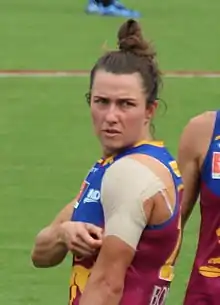 Cathy Svarc is from Corowa
Cathy Svarc is from Corowa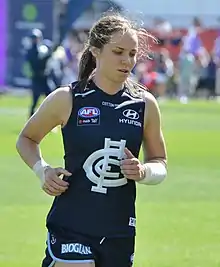 Chloe Dalton is from Sydney
Chloe Dalton is from Sydney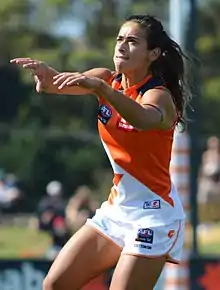 Amanda Farrugia was recruited from Sydney
Amanda Farrugia was recruited from Sydney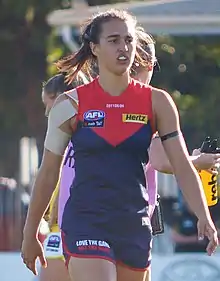 Brenna Tarrant is from Blaxland
Brenna Tarrant is from Blaxland Nicola Barr was schooled in Sydney
Nicola Barr was schooled in Sydney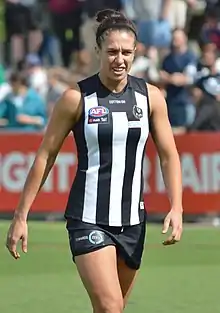 Ashleigh Brazill is from Wollondilly, New South Wales
Ashleigh Brazill is from Wollondilly, New South Wales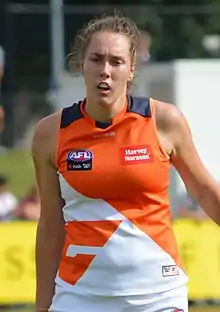 Erin McKinnon All Australian was recruited from Sydney
Erin McKinnon All Australian was recruited from Sydney Rebecca Beeson was recruited from Sydney
Rebecca Beeson was recruited from Sydney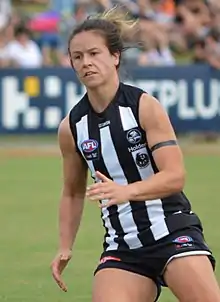 Sophie Casey is from Holbrook
Sophie Casey is from Holbrook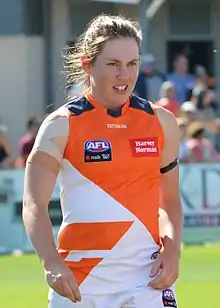 Jodie Hicks is from Hay
Jodie Hicks is from Hay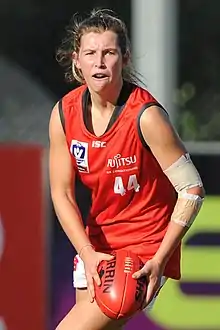 Maddy Collier was recruited from Sydney
Maddy Collier was recruited from Sydney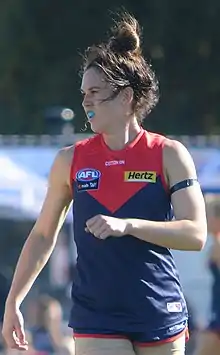 Gabrielle Colvin is from Wagga
Gabrielle Colvin is from Wagga
ALFW players from NSW
| Currently on an AFLW senior list |
| Player | NSW junior/senior club/s | Representative honours | AFLW Draft | Selection | AFLW Years | AFLW Games | AFLW (Goals) | Connections to NSW, Notes & References |
|---|---|---|---|---|---|---|---|---|
| Teagan Germech | Bathurst, East Coast Eagles | 2023- | 1 | - | Raised in Bathurst | |||
| Alice Mitchell | Pittwater, Mosman, Gunnedah | 2023- | 1 | - | Raised in Sydney | |||
| Tanya Kennedy | Inner West Magpies, UTS | 2023- | 1 | - | Recruited from Sydney | |||
| Brianna McFarlane | Lower Clarence | 2023- | 1 | - | Raised in Yamba | |||
| Dominique Carruthers | North Shore, Macquarie University | 2023- | 1 | - | Raised in Sydney | |||
| Madeline Hendrie | East Sydney, UNSW-Eastern Suburbs, Sydney Swans Academy | 2023- | 1 | - | Raised in Sydney | |||
| Eleri Morris | Northern Districts, Wollongong, Inner West Magpies, GWS Giants Academy | 2023- | 1 | - | Raised in and recruited from Illawarra | |||
| Jess Doyle | Manly Warringah, Sydney Swans Academy | 2021 | #49 | 2022- | 1 | - | Raised in and recruited from Sydney | |
| Georgina Fowler | St Ives, East Coast Eagles, GWS Giants Academy | 2022- | 3 | - | Raised in and recruited from Sydney | |||
| Brodee Mowbray | Camden, Southern Power | 2022- | 12 | 3 | Raised in Camden, Greater Western Sydney | |||
| Ally Dallaway | East Coast Eagles | 2022- | 20 | - | Raised in Sydney | |||
| Ally Morphett | East Wagga-Kooringal, Murray U18 | 2022- | 16 | 1 | Raised in Gumly Gumly (Wagga) | |||
| Jasmine Simmons | North Broken Hill, Gol Gol | 2022- | 8 | - | Raised in Broken Hill | |||
| Ruby Sargent-Wilson | Southern Power, Sydney Swans Academy | U18 (2019) | 2022- | -4 | - | Raised in and recruited from Wollongong (Woonona) | ||
| Gabrielle Biedenweg-Webster | Wollongong | 2022- | 1 | 0 | Raised in Wollongong (Wiradjuri) | |||
| Ruby Svarc | - | 2021- | 23 | 6 | Raised in Corowa | |||
| Tarni Evans | Tathra, Queanbeyan | 2020 | #9 | 2021- | 19 | 1 | Raised in Tathra, recruited from Queanbeyan | |
| Cathy Svarc | - | 2020- | 43 | 12 | Raised in Corowa | |||
| Gabrielle Colvin | - | 2019 | #77 | 2020- | 25 | 0 | Raised in and recruited from Wagga Wagga | |
| Lisa Steane | Nelson Bay | 2019 | #23 | 2020- | 27 | 0 | Born, raised in and recruited from Nelson Bay | |
| Georgia Garnett | East Coast Eagles | 2019 | #90 | 2020- | 24 | 7 | Raised in and recruited from Sydney | |
| Brenna Tarrant | Emu Plains Glenmore Lions (juniors), Kellyville Rouse Hill Magpies (juniors), East Coast Eagles (seniors) | 2019 | #72 | 2020- | 25 | 1 | Raised in Blaxland (Blue Mountains), recruited from Sydney | |
| Emily Goodsir | East Coast Eagles | 2019 | #76 | 2020- | 10 | 0 | Raised in and recruited from Sydney | |
| Tarnee Tester | West Broken Hill | 2019 | #56 | 2020-2021 | 4 | 1 | Born and raised in Broken Hill (Barkindji) | |
| Alyce Parker | Thurgoona | 2018 | #12 | 2019- | 42 | 4 | Raised in Holbrook, recruited from Thurgoona | |
| Chloe Dalton | - | 2018 | Rookie | 2019- | 22 | 6 | Raised in and recruited from Sydney | |
| Taylah Davies | - | Rookie | 2018- | - | - | Born, raised in and recruited from Wollongong | ||
| Jodie Hicks | - | 2017 | #5 | 2018- | 30 | 4 | Born, raised in and recruited from Hay | |
| Ashleigh Brazill | - | 2017 | #34 | 2018- | 24 | 4 | Born, raised in and recruited from Wollondilly (Sydney) | |
| Sophie Casey | Holbrook, Riverina | 2016 | Free agent | 2017- | 53 | 2 | Raised in Holbrook, recruited from Wagga Wagga | |
| Rebecca Beeson | UNSW-Eastern Suburbs | 2016 | #32 | 2017- | 41 | 7 | Born, raised in and recruited from Sydney | |
| Erin McKinnon | Mosman | 2016 | #48 | 2017- | 46 | 1 | Raised in and recruited from Sydney | |
| Nicola Barr | Sydney University | 2016 | #1 | 2017- | 48 | 9 | Raised in and recruited from Sydney | |
| Maddy Collier | UNSW-Eastern Suburbs | 2016 | Priority | 2017- | 39 | 3 | Raised in and recruited from Sydney | |
| Haneen Zreika | Auburn-Penrith Giants | 2017 (Rookie) | Rookie (#1) | 2017- | 39 | 7 | Born, raised in and recruited from Sydney | |
| Hannah Dunn | Queanbeyan | Backup | 2017- | 35 | 0 | Recruited from Queanbeyan | ||
| Leah Kaslar | - | 2016 | #31 | 2017-2021 | 36 | 3 | Born Caringbah (Sydney) | |
| Ellie Brush | - | 2016 | Rookie | 2017-2020 | 20 | 1 | Recruited from Sydney | |
| Amanda Farrugia | Macquarie University | 2016 | #64 | 2017-2019 | 21 | 2 | Born, raised in and recruited from Sydney | |
| Renee Tomkins | - | 2016 | #96 | 2017-2019 | 12 | 0 | Born, raised in and recruited from Sydney | |
| Nikki Wallace | Sawtell Toormina Saints | 2016 | #114 | 2017 | 8 | 0 | Raised in Coffs Harbour | |
| Kristy De Pellegrini | Southern Power | 2016 | #81 | 2017 | 6 | 0 | Raised in and recruited from Sydney | |
| Stephanie Walker | Sydney University | 2016 | #113 | 2017 | 3 | 1 | Raised in and recruited from Sydney | |
| Codie Briggs | Newtown | 2016 | Free agent | 2017 | 3 | 0 | Raised in and recruited from Sydney |
Representative team
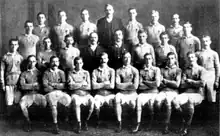
The New South Wales representative team, nicknamed the Blues, played Interstate matches against other Australian states and Territories. The team wore a blue uniform with a Waratah symbol badge and, until the 1970s, was the only representative team to buck the trend of sleeveless guernseys fit with the fashions in rugby. The Blues defeated the Victoria team in 1923 and again in 1990 under State of Origin rules at the Sydney Cricket Ground. Its final appearance was at the 1988 Adelaide Bicentennial Carnival.
In 1993, the game's new governing body, the AFL Commission created a composite team with the Australian Capital Territory, the NSW/ACT Rams. Notable New South Welshmen in this team included Wayne Carey and Brownlow Medalist Shane Crawford. Senior players have not represented the state since.
NSW was an inaugural participant in the National underage titles. It competed from 1993 to 2016 as NSW/ACT, after which it was dropped from the national championships and instead now competes in the TAC Cup.
Principal venues
The following venues are the largest that meet AFL Standard criteria and have been used to host AFL (National Standard) or AFLW level matches (Regional Standard) and have hosted such matches in the last decade:[89]
| Sydney | Sydney | Sydney |
|---|---|---|
| Stadium Australia | Sydney Cricket Ground | Sydney Showground Stadium |
| Capacity: 82,500 | Capacity: 48,000 | Capacity: 25,500 |
 |
.jpg.webp) |
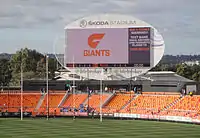 |
| Sydney | Sydney | Wagga Wagga |
| Henson Park | North Sydney Oval | Robertson Oval |
| Capacity: 30,000 | Capacity: 16,000 | Capacity: 10,000 |
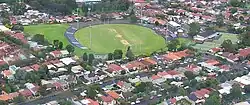 |
.jpg.webp) |
 |
| Western Sydney | Sydney | Western Sydney |
| Blacktown ISP Oval | Drummoyne Oval | Tom Wills Oval |
| Capacity: 10,000 | Capacity: 6,000 | Capacity: 3,000 |
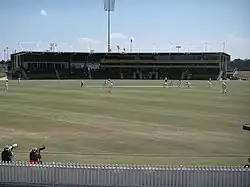 |
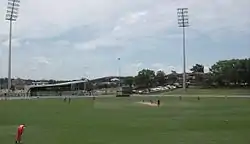 |
Sydney
- Sydney Cricket Ground
- Stadium Australia, Sydney Olympic Park
- Sydney Showground Stadium, Sydney Olympic Park
- North Sydney Oval
- Blacktown ISP Oval, Rooty Hill
- Bruce Purser Reserve, Kellyville
- Ern Holmes Oval, Pennant Hills
- Henson Park, Marrickville
- Picken Oval, Croydon Park
- Trumper Park Oval, Paddington
- Monarch Oval, Macquarie Fields
- Village Green, University of New South Wales, Kensington
- Drummoyne Oval
- Gore Hill Oval
- Olds Park, Penshurst
- University Oval, University of Sydney
- Jubilee Oval, Carlton
Regional NSW
- Lavington Sports Ground, Hamilton Valley, Albury
- Newcastle Number 1 Sports Ground, Newcastle
- Coffs Harbour International Stadium, Coffs Harbour
- Narrandera Sports Ground, Narrandera
- North Dalton Park, Towradgi, Wollongong
- Robertson Oval, Wagga Wagga
Books
- de Moore, Greg; Hess, Rob; Nicholson, Matthew; Stewart, Bob (2021). Australia's Game: The History of Australian Football. Hardie Grant Books. ISBN 9781-74379-657-3.
- Blake, Martin (2013). The rise of the Swans : a decade of success : 2003-12. Melbourne, Vic.: Penguin Group (Australia). ISBN 978-1-921901-69-0. OCLC 829056262.
See also
References
- 1 2 "Football in Sydney". The Australasian. Vol. I, no. 10. Victoria, Australia. 9 June 1866. p. 11. Retrieved 29 April 2022 – via National Library of Australia.
- 1 2 Ausplay Participation by Activity/State
- ↑ AFL Sydney Hall of Fame
- ↑ "Advertising". The Sydney Morning Herald. Vol. LII, no. 8501. New South Wales, Australia. 19 August 1865. p. 4. Retrieved 1 May 2022 – via National Library of Australia.
- ↑ "NOTES OF THE WEEK". The Sydney Morning Herald. Vol. LII, no. 8507. New South Wales, Australia. 26 August 1865. p. 8. Retrieved 29 April 2022 – via National Library of Australia.
- 1 2 de Moore et al. 2021, p. 187.
- 1 2 3 de Moore et al. 2021, p. 186.
- ↑ Bell's Life in Sydney. 18 July 1867
- ↑ Bell's Life in Sydney. 3 August 1867
- 1 2 de Moore et al. 2021, p. 188.
- ↑ "FROM THE 3RD JULY TO THE 10TH JULY". The Sydney Morning Herald. Vol. LVIII, no. 9408. New South Wales, Australia. 15 July 1868. p. 5. Retrieved 1 May 2022 – via National Library of Australia.
- ↑ "TOWN AND COUNTRY". Sydney Mail. Vol. IX, no. 419. New South Wales, Australia. 11 July 1868. p. 5. Retrieved 29 April 2022 – via National Library of Australia.
- ↑ de Moore et al. 2021, p. 190.
- ↑ "INTERCOLONIAL FOOTBALL MATCH". The Argus (Melbourne). No. 9, 680. Victoria, Australia. 25 June 1877. p. 6. Retrieved 25 November 2021 – via National Library of Australia.
- ↑ "SPORTING". The Sydney Morning Herald. Vol. LXXVIII, no. 12, 520. New South Wales, Australia. 5 July 1878. p. 5. Retrieved 30 March 2023 – via National Library of Australia.
- ↑ "Football Notes". The Sydney Mail and New South Wales Advertiser. Vol. XXX, no. 1045. New South Wales, Australia. 17 July 1880. p. 124. Retrieved 30 March 2023 – via National Library of Australia.
- ↑ "THE INTERCOLONIAL FOOTBALL MATCH". The Argus (Melbourne). No. 10, 931. Victoria, Australia. 1 July 1881. p. 3. Retrieved 30 March 2023 – via National Library of Australia.
- ↑ de Moore et al. 2021, p. 192.
- ↑ "FOOTBALL". The Sydney Morning Herald. No. 14, 127. New South Wales, Australia. 9 July 1883. p. 6. Retrieved 13 May 2022 – via National Library of Australia.
- ↑ "FOOTBALL". The Sydney Morning Herald. No. 14, 129. New South Wales, Australia. 11 July 1883. p. 8. Retrieved 14 May 2022 – via National Library of Australia.
- ↑ "FOOTBALL". Evening News. No. 5340. New South Wales, Australia. 27 June 1884. p. 3. Retrieved 14 May 2022 – via National Library of Australia.
- ↑ New South Wales vs New Zealand from NSW Australian Football History Society
- ↑ 1888 Northern Districts Football Association NSW Australian Football Historical Sociey
- ↑ M. P. Sharp, Football in Sydney before 1914 Archived 3 July 2008 at the Wayback Machine, Sporting Traditions Vol 4 No 1 November 1987.
- ↑ "FOOTBALL IN SYDNEY". The Argus (Melbourne). No. 17, 742. Victoria, Australia. 25 May 1903. p. 6. Retrieved 24 November 2021 – via National Library of Australia.
- ↑ "FOOTBALL GOSSIP". Leader. No. 2483. Victoria, Australia. 8 August 1903. p. 17. Retrieved 7 October 2021 – via National Library of Australia.
- ↑ "MATCH IN SYDNEY". The Argus (Melbourne). No. 18, 057. Victoria, Australia. 30 May 1904. p. 9. Retrieved 24 November 2021 – via National Library of Australia.
- ↑ "AUSTRALIAN FOOTBALL". The Australian Star. No. 5417. New South Wales, Australia. 24 June 1905. p. 8 (FIRST EDITION). Retrieved 7 October 2021 – via National Library of Australia.
- ↑ "Australian Football". The Sydney Mail and New South Wales Advertiser. Vol. LXXXIII, no. 2379. New South Wales, Australia. 12 June 1907. p. 1504. Retrieved 29 March 2023 – via National Library of Australia.
- ↑ "Football in Sydney: Rugby and Australian". The Sydney Mail and New South Wales Advertiser. Vol. LXXXV, no. 2432. New South Wales, Australia. 17 June 1908. p. 1583. Retrieved 29 March 2023 – via National Library of Australia.
- ↑ "THE AUSTRALIAN RULES GAME". The Daily Telegraph. No. 9685. New South Wales, Australia. 13 June 1910. p. 9. Retrieved 29 March 2023 – via National Library of Australia.
- ↑ "SYDNEY AND GEELONG (AUSTRALIAN RULES)". The Sun. No. 489. New South Wales, Australia. 11 August 1912. p. 1. Retrieved 29 March 2023 – via National Library of Australia.
- ↑ S. Fagan, 'Rules' Almost Had Sydney's Paddock Archived 17 May 2008 at the Wayback Machine in rl1908.com, 2006.
- 1 2 "Australian Football is Established on Paying Basis in Sydney". The Herald. No. 14, 164. Victoria, Australia. 6 August 1921. p. 4 (Sporting Edition). Retrieved 14 September 2022 – via National Library of Australia.
- ↑ NSW vs Melbourne FC 28 July 1923 from NSW Football History
- ↑ NSW vs Victoria 15 August 1925 from NSW Football History
- ↑ NSW Football History - St George Junior Association 4 June 2015
- ↑ Jim Main, Shake Down The Thunder, Geoff Slattery Publishing, 2006, ISBN 0-9757964-6-1
- ↑ "SYDNEY-BASED TEAM ULTIMATE AIM OF V.F.L." The Canberra Times. Vol. 54, no. 16, 278. Australian Capital Territory, Australia. 20 April 1980. p. 26. Retrieved 24 November 2021 – via National Library of Australia.
- 1 2 3 4 "AUSTRALIAN FOOTBALL Clubs will decide on fate of Sydney VFL team". The Canberra Times. Vol. 55, no. 16, 701. Australian Capital Territory, Australia. 18 June 1981. p. 28. Retrieved 2 May 2022 – via National Library of Australia.
- ↑ Hot Spots – Breeding Grounds of Today's AFL Footballers Archived 2 November 2012 at the Wayback Machine from theage.com.au
- ↑ "1881 - Football". Wagga Wagga Advertiser. Wagga Wagga Advertiser (NSW). 2 August 1881. p. 2. Retrieved 23 February 2022.
- ↑ "1888 - Wagga Football Association". Wagga Wagga Advertiser. Wagga Wagga Advertiser (NSW). 2 October 1888. p. 2. Retrieved 23 February 2022.
- ↑ "1890 - Wagga United Football Association". Wagga Wagga Advertiser (NSW). 1 May 1890. p. 2. Retrieved 23 February 2022.
- ↑ "1923 - Football - Australian Rules". Daily Advertiser (Wagga Wagga, NSW). 14 May 1923. p. 2. Retrieved 22 February 2022.
- ↑ "1924 - Football". Daily Advertiser. Daily Advertiser (Wagga Wagga, NSW). 21 April 1924. p. 4. Retrieved 22 February 2022.
- ↑ "1925 - Mangoplah wins PA Cup". Daily Advertiser. Daily Advertiser (Wagga Wagga, NSW). 9 September 1925. p. 6. Retrieved 23 February 2022.
- ↑ "1926 - Australian Rules Football Crisis". Daily Advertiser. Daily Advertiser (Wagga Wagga, NSW). 10 April 1926. p. 4. Retrieved 23 February 2022.
- ↑ "1926 - The Rock Cup Final". Daily Advertiser. Daily Advertiser (Wagga Wagga, NSW. 16 September 1926. p. 4. Retrieved 23 February 2022.
- ↑ "1926 - Newtown Premiers". Daily Advertiser. Daily Advertiser (Wagga Wagga, NSW). 6 September 1926. p. 3. Retrieved 23 February 2022.
- ↑ "1927 - Rovers defest Currawarna". Daily Advertiser (Wagga Wagga, NSW). 12 September 1927. p. 4. Retrieved 23 February 2022.
- ↑ "1905 - Fitzroy v Wagga". Wagga Wagga Express (NSW). 22 June 1905. p. 3. Retrieved 23 February 2022.
- ↑ "RUGBY IS OUSTING CODE IN RIVERINA". Sporting Globe. No. 2523. Victoria, Australia. 24 August 1946. p. 6 (Edition2). Retrieved 25 September 2022 – via National Library of Australia.
- ↑ "1907 – Central Riverina Football League". Narandera Argus and Riverina Advertiser (NSW). 31 May 1907. p. 2. Retrieved 25 February 2022.
- ↑ "1912 - Football". Narandera Argus and Riverina Advertiser (NSW). 24 May 1912. p. 6. Retrieved 25 December 2022.
- ↑ "A Brief History Of Football In Broken Hill". 2 May 2006. Archived from the original on 2 May 2006. Retrieved 24 July 2023.
- 1 2 "Football gold mined in coal country". Australian Football 150 Years. Australian Football League. Archived from the original on 6 July 2011. Retrieved 18 March 2010.
- ↑ "History of football in this league". Black Diamond AFL. Retrieved 18 March 2010.
- ↑ "Black Diamond Football League Kicking Goals in Grassroots Administration". SportingPulse. 30 September 2002. Retrieved 18 March 2010.
- ↑ "LOCAL NEWS". The Maitland Mercury and Hunter River General Advertiser. Vol. XLVI, no. 6394. New South Wales, Australia. 18 April 1889. p. 5. Retrieved 14 July 2021 – via National Library of Australia.
- ↑ "NORTHERN FOOTBALL ASSOCIATION". Newcastle Morning Herald and Miners' Advocate. Vol. XVI, no. 11, 064. New South Wales, Australia. 17 April 1889. p. 3. Retrieved 14 July 2021 – via National Library of Australia.
- ↑ "A FOOTBALL TROPHY". Newcastle Morning Herald and Miners' Advocate. Vol. XVI, no. 11, 106. New South Wales, Australia. 7 June 1889. p. 8. Retrieved 14 July 2021 – via National Library of Australia.
- ↑ "AFLSC Seniors". GameDay. Retrieved 24 July 2023.
- ↑ "Junior AFL In The Wollongong Region - A Brief Hist". My Game Day. 3 March 2008. Retrieved 24 July 2023.
- ↑ Wilks, M. (2011) Australian football clubs in NSW Bas Publishing. p. 141
- ↑ "Call to include Sydney in VFL". The Canberra Times. Vol. 52, no. 14, 965. Australian Capital Territory, Australia. 23 December 1977. p. 12. Retrieved 12 May 2023 – via National Library of Australia.
- ↑ "VFL to approach SGG". The Canberra Times. Vol. 52, no. 15, 571. Australian Capital Territory, Australia. 27 April 1978. p. 1 (SPORTS SECTION). Retrieved 12 May 2023 – via National Library of Australia.
- ↑ "SYDNEY-BASED TEAM ULTIMATE AIM OF V.F.L." The Canberra Times. Vol. 54, no. 16, 278. Australian Capital Territory, Australia. 20 April 1980. p. 26. Retrieved 24 November 2021 – via National Library of Australia.
- ↑ 1980 VFL Move to Sydney from NSW Football History
- ↑ "Timeline: Tough times see the Swans fly north (1960–1984)". Retrieved 9 April 2022.
- ↑ "Finals Flashback: 2005 AFL Grand Final". ABC News (Australian Broadcasting Corporation). 26 September 2014. Retrieved 11 July 2020.
- ↑ "Swans snatch victory in classic grand final". ABC News (Australian Broadcasting Corporation). 1 October 2012. Retrieved 11 July 2020.
- ↑ Footy Flashbacks: North Melbourne By Zachary Gates on 17 May 2019
- ↑ AFL courts Sydney market Archived 4 March 2016 at the Wayback Machine ABC Radio transcript
- ↑ McGowan, Marc. "Gargantuan: Depleted Giants shock Pies to reach first Grand Final". AFL.com.au. Archived from the original on 15 September 2019. Retrieved 24 September 2019.
- ↑ Failed experiment GWS Giants the elephant in the change room by Adam Schwabsep for crikey.com.au 26 September 2016
- ↑ Has the AFL lost the war for western Sydney from The Australian 13 May 2022
- ↑ "AFL women's teams announced – AFL.com.au". afl.com.au. Retrieved 19 October 2018.
- 1 2 Beyond the Boundary with Baker: Learnings from Round 1 By Baker Denneman, Sydney Swans
- ↑ Ausplay Australian Football report 2019
- ↑ Ed. Michael Lovett (2013) AFL Record Season Guide 2013. Slattery Media Group. p 1066
- ↑ Ed. Michael Lovett (2012) AFL Record Season Guide 2012 & 2013. Slattery Media Group. p 1008 & 1034
- ↑ "4901.0 - Children's Participation in Cultural and Leisure Activities, Australia, Apr 2009". Archived from the original on 22 May 2016. Retrieved 2010-12-19.
- ↑ "4177.0 - Participation in Sport and Physical Recreation, Australia, 2011-12". Archived from the original on 4 March 2016. Retrieved 2013-11-02.
- ↑ More chase Sherrin than before – realfooty.com.au Archived 4 February 2009 at the Wayback Machine
- ↑ "Sydney Swans Crowds and Match Attendances". Archived from the original on 4 March 2016. Retrieved 2013-10-28.
- ↑ "CHRONOLOGICAL HISTORY OF NSW FOOTBALL – NSW Australian Football History Society Inc". Archived from the original on 29 July 2016. Retrieved 2014-01-25.
- ↑ Wilks, M. (2011) Australian football clubs in NSW Bas Publishing. ISBN 9781921496134 p. 61 & 75
- ↑ AFL PREFERRED FACILITY GUIDELINES Aflcommunityclub.com.au
External links
- The Hidden Story of Australian Rules in Sydney
- NSW Footy History
- Australian Rules Almost Held Sydney
- "NSW Team of the Century". Full Points Footy. Archived from the original on 9 January 2012.
- Sydney Australian Football Foundation – non-profit organisation assisting development of the code in Sydney